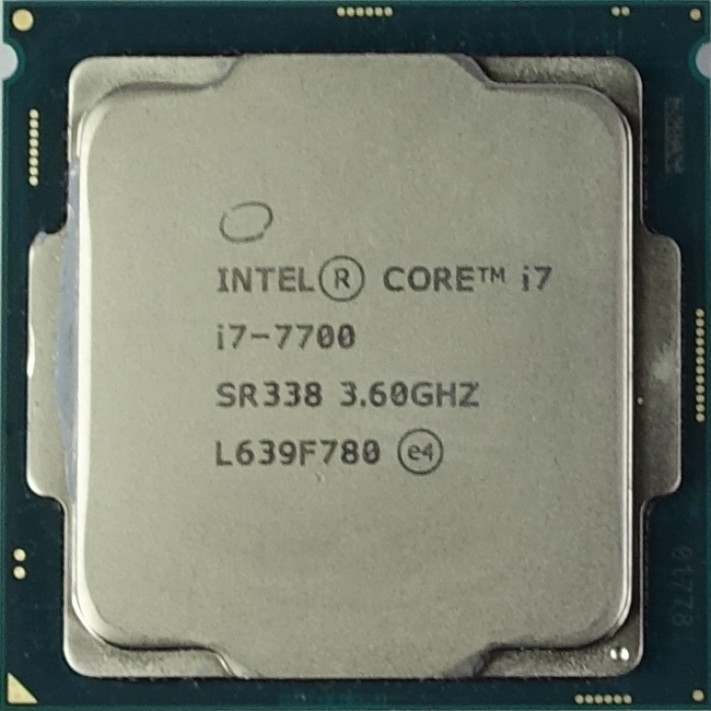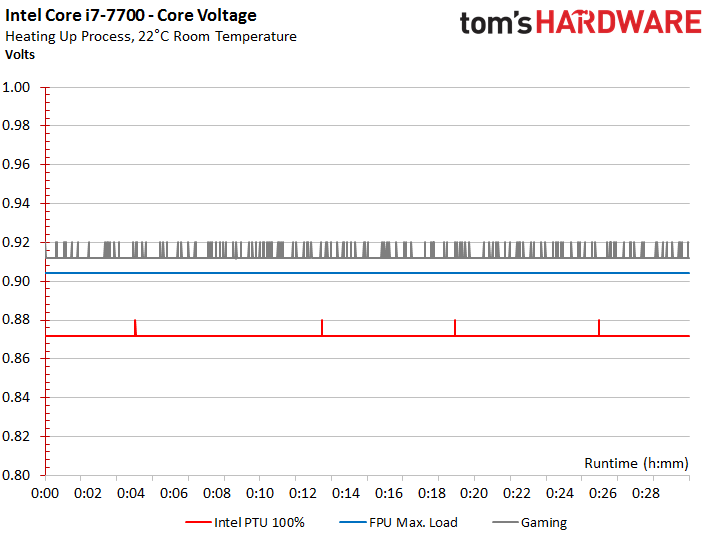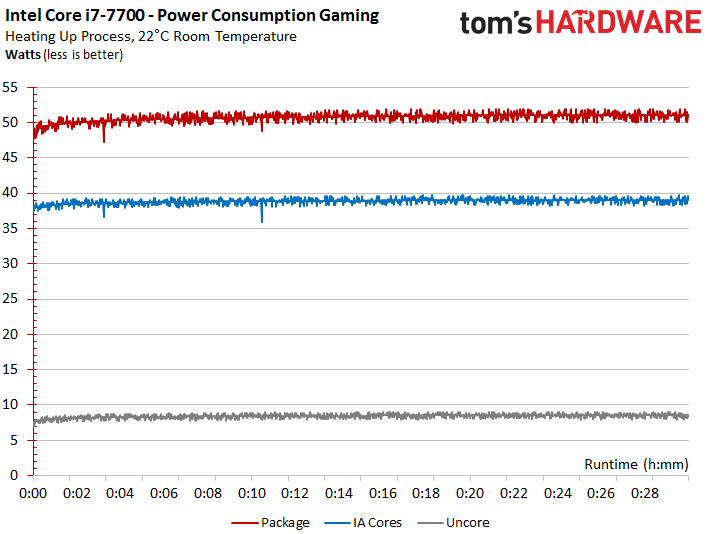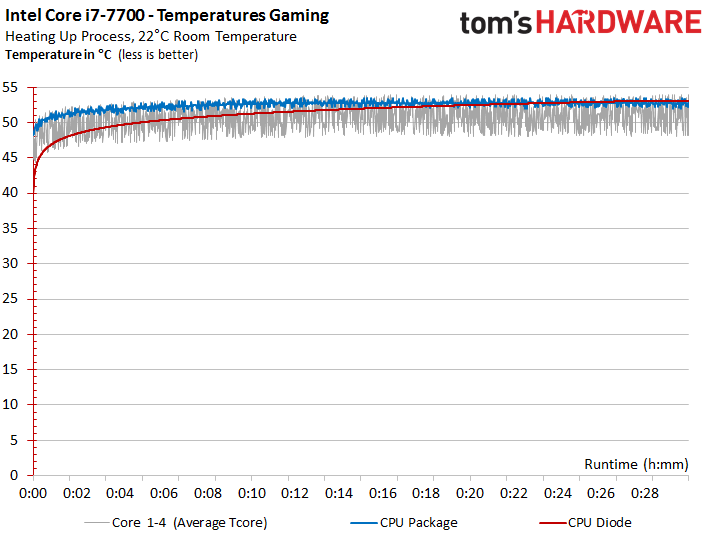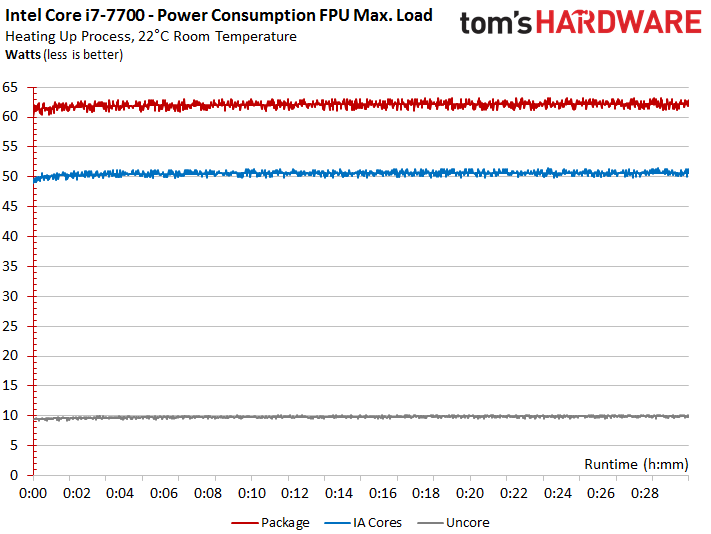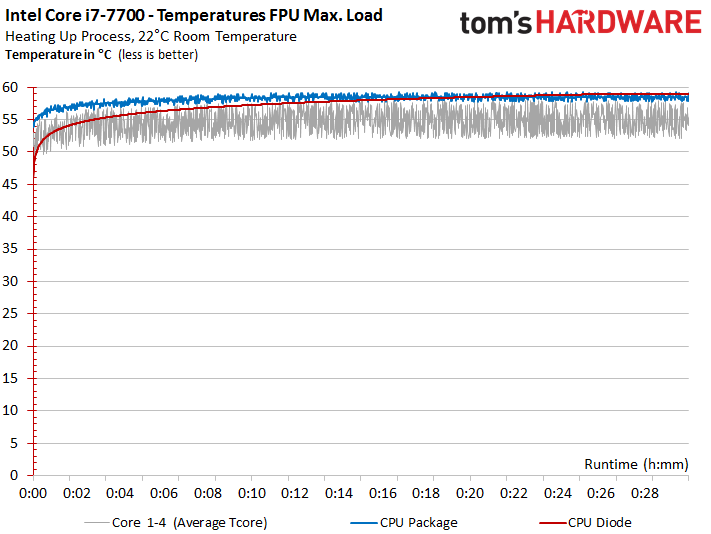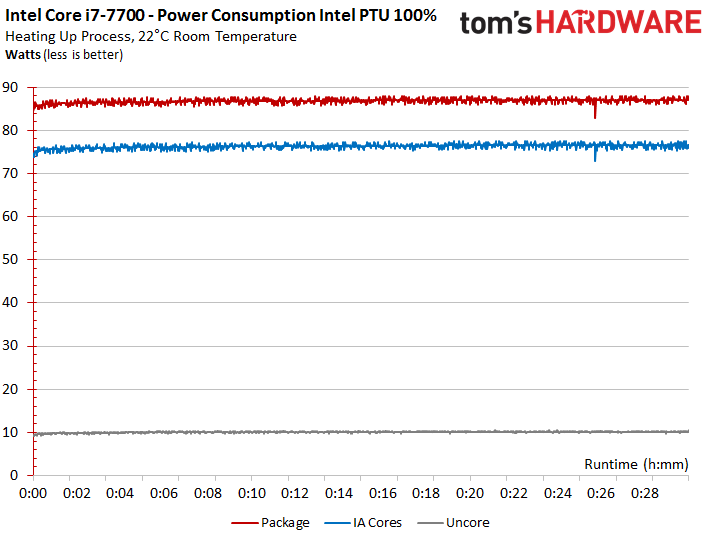Intel Kaby Lake Core i7-7700K, i7-7700, i5-7600K, i5-7600 Review
Intel Core i7-7700: Power Consumption And Temperatures
As opposed to the Core i7-7700K, Intel's Core i7-7700 (without the K) doesn’t have an unlocked multiplier. Its base clock rate is also quite a bit lower. Furthermore, Intel chose some of the other values, such as those for the ring bus, to make overclocking endeavors via the BCLK pointless.
The Core i7-7700’s stock base frequency is 3.6 GHz. However, even under extreme loads, the processor manages to hold a 4 GHz Turbo Boost frequency on all four cores.
Core Voltage (Vcore)
Before we get to the power consumption and temperature numbers, let's take a look at the core voltage (Vcore). This shouldn’t be confused with the voltage identification (VID) that can be set in the BIOS and is always higher than the Vcore.
It’s plain to see that the voltage decreases as the loads increase. This is necessary to ensure the Core i7-7700’s maximum leakage currents aren’t exceeded, which could damage the CPU. The more taxing the load, the less the curve fluctuates as well.
Normal Load: Gaming
We again use Watch Dogs 2 for our gaming load. In this task, Intel’s CPU consumes a total of 50 to 52W. That's a great result, and it comes in well below the processor's TDP. The IA cores only consume 40W, with the rest going to other parts of the die.
Again, the CPU’s power consumption increases along with its temperature. This results in additional leakage currents of up to 1.7W.
The rate of the temperature increase over time depends on the position of the sensor. Readings stabilize after more than 24 minutes, though. The package heats up more slowly than the other components.
Get Tom's Hardware's best news and in-depth reviews, straight to your inbox.
Heavy Load: Stress Test (Floating-Point Unit)
We're back to AIDA64's stability test, which results in an increased power consumption measurement of 63W. The temperature and leakage current increases are similar to what we saw during the gaming power consumption benchmark.
The Tcore increases noticeably up to 58°C. Other than that, the readings are similar to what we saw in the gaming power consumption benchmark. Even simple air coolers shouldn’t have a problem coping with this amount of waste heat.
Maximum Load: Intel Power Thermal Utility (100%)
We push the Core i7-7700 just about as far as it will go using Intel’s Power Thermal Utility. A measurement of up to 88W comes close to Intel’s stated TDP. It’s interesting that the increase in leakage currents doesn’t exceed 2W when comparing the cold and warmed-up CPUs.
The temperature results show us that the CPU diode stays a bit cooler than the other parts, whereas the package sensor displays the highest temperatures.
In the end, it looks like we drew an average CPU sample. Cooling the vanilla Core i7-7700 isn't particularly challenging. A maximum clock rate of 4 GHz across all four cores under heavy load strikes a good balance between efficiency, compute power, and waste heat. However, it’s not enough to reach the Core i7-7700K’s performance.
Current page: Intel Core i7-7700: Power Consumption And Temperatures
Prev Page Intel Core i7-7700K: Power Consumption And Temperatures Next Page Intel Core i5-7600K: Power Consumption And Temperatures
Igor Wallossek wrote a wide variety of hardware articles for Tom's Hardware, with a strong focus on technical analysis and in-depth reviews. His contributions have spanned a broad spectrum of PC components, including GPUs, CPUs, workstations, and PC builds. His insightful articles provide readers with detailed knowledge to make informed decisions in the ever-evolving tech landscape
-
Based on our initial testing, we can confirm that HD Graphics 630 does not function correctly under Windows 7 and 8.1. Both operating systems install generic drivers for the display adapter, even after applying the latest drivers and updates, so many core features remain unavailable. We also experienced stability issues with Windows 7 that might even negate using an add-in GPU as a workaround.Reply
Not true, i setup Kaby Lake in my lab and everything works fine under Windows 7. Did you guys even try to apply drivers for HD Graphic 630? -
adgjlsfhk It would have been kind of nice to see igpu vs gtx 750 and other low end discrete graphics cards, but other than that, great review.Reply -
cknobman Boooooooooooooooooring.Reply
Bring on the new AMD cpu's!!!
Oh, nice review the boring is not Toms fault ;) -
Jim90 "Intel’s slow cadence of incremental upgrades hasn’t done much to distance its products from AMD's.Reply
"...Obviously we need a competitive AMD to help reinvigorate the desktop PC space."
Without real competition the only risk Intel takes with the Desktop market is to loose sight of (i.e. actively ignore) the performance jump the consumer expects in a new release. Continual and lengthy minor incremental updates (pretty much what we've seen since the 2000 series) may well lead to consumer apathy. I certainly haven't upgraded 'as much as I could!' recently. Absolutely no justifiable need.
Then again, perhaps we've all had access to enough power we need? We used to talk about 'killer apps/software' to drive consumers into making a purchase. This certainly did work. Maybe new tech (currently available) isn't killer enough? We need another '3dfx Voodoo' experience?
VR is certainly (definite?) a potential driver...here's hoping for speedy and significant updates here. -
Paul Alcorn Reply19098433 said:Based on our initial testing, we can confirm that HD Graphics 630 does not function correctly under Windows 7 and 8.1. Both operating systems install generic drivers for the display adapter, even after applying the latest drivers and updates, so many core features remain unavailable. We also experienced stability issues with Windows 7 that might even negate using an add-in GPU as a workaround.
Not true, i setup Kaby Lake in my lab and everything works fine under Windows 7. Did you guys even try to apply drivers for HD Graphic 630?
Hello, yes we did test and attempt to install the HD Graphics 630 drivers. We are working with early BIOS revisions, so it is possible that we encountered a platform-specific issue. Can you share which motherboard you used for your testing? Any feedback is welcome.
-
ohim Why are they even releasing this ? It makes absolutely no sense to release such a product ...Reply -
redgarl Reply19098782 said:Why are they even releasing this ? It makes absolutely no sense to release such a product ...
Probably to make a statement of some kind.
-
FormatC Reply
You really have drivers for the Z270 chipset with official support of Windows 7 from intel and Microsoft? I tried it also and was not able to run KL with all features on a W7 installation. It runs, somehow. :)19098433 said:Not true, i setup Kaby Lake in my lab and everything works fine under Windows 7. Did you guys even try to apply drivers for HD Graphic 630? -
valeman2012 Just notice that people that are using these CPU you need Windows 10 to have everything working 100%.Reply
